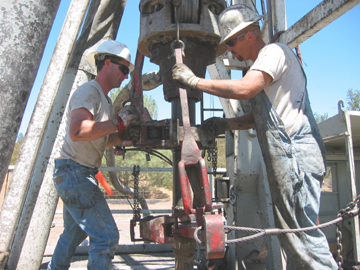
Geotimes Home | AGI Home | Information Services | Geoscience Education | Public Policy | Programs | Publications | Careers

 For more than a decade,
seismologists have been waiting, instruments ready, in a small town in the hills
of Southern California for another earthquake to shake along the San Andreas fault.
The town is Parkfield, a name associated with the U.S. Geological Survey’s
(USGS) failed earthquake prediction experiment during the 1980s. The 25-kilometer-long
stretch of the San Andreas has experienced at least five magnitude-6.0 quakes
since 1857. The latest earthquake was in 1966. Based on the periodic nature of
these events, USGS researchers predicted an earthquake recurrence every 22 years
with the next earthquake shaking things up by 1993. That earthquake never came.
For more than a decade,
seismologists have been waiting, instruments ready, in a small town in the hills
of Southern California for another earthquake to shake along the San Andreas fault.
The town is Parkfield, a name associated with the U.S. Geological Survey’s
(USGS) failed earthquake prediction experiment during the 1980s. The 25-kilometer-long
stretch of the San Andreas has experienced at least five magnitude-6.0 quakes
since 1857. The latest earthquake was in 1966. Based on the periodic nature of
these events, USGS researchers predicted an earthquake recurrence every 22 years
with the next earthquake shaking things up by 1993. That earthquake never came.
 |
Geotimes Home | AGI Home | Information Services | Geoscience Education | Public Policy | Programs | Publications | Careers |